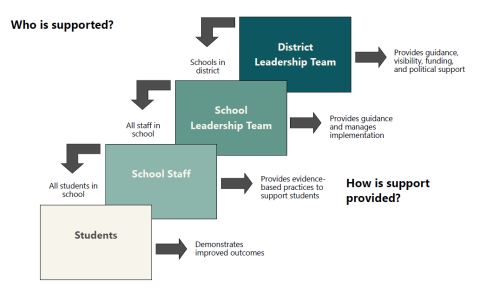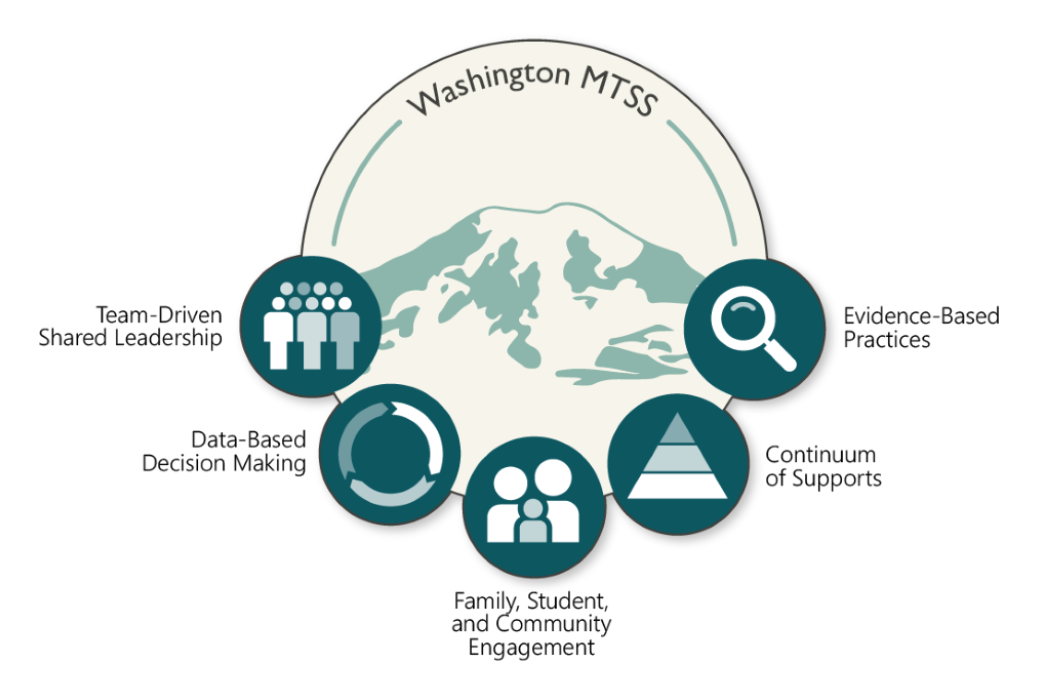MTSS Components and Resources
Quick Resources
Contact Information
The essential components of Multi-Tiered Systems of Support (MTSS) are interrelated, and as the intensity of student need increases, each of the components also increases in intensity. Teams share the responsibility of making decisions in an MTSS framework. These decisions are driven by high-quality data, collected over time, from multiple sources. Teams engage families, students, and community partners to plan, implement, and improve services. Staff and community partners provide a continuum of supports to students through a tiered delivery system, starting with strong core instruction. Staff use evidence-based practices to accelerate student learning across all tiers. Below is information that will expand on these five components and supply resources that will assist in the use of these core components.
MTSS Essential Components
- Team Driven Shared Leadership
-
Sustained Implementation of MTSS is dependent on building the capacity of the organization to lead and support the essential MTSS components. This is done by leadership teams who share the responsibility to support all adults in the school building by planning, coordinating, monitoring, and adjusting MTSS implementation activities. Leadership teams are responsible for building the capacity of the team to lead the work as well as providing ongoing training and support to staff, families, and community partners to implement as intended. Leadership teams should have broad representation and an established process to regularly solicit input and collect data from staff, students, families, and community partners. This feedback helps drive implementation decisions. These teams also use validated tools to assess capacity, and Schoolwide PBIS Tiered Fidelity Inventory and Reading Tiered Fidelity Inventory to assess fidelity of implementation in order to prevent drift from the core, evidence-based features of the system.
Resources
- Data-Based Decision-Making
-
Teams at all levels of the system (district, school, grade) use data to inform decision-making. District and school teams use an agreed-upon process to guide their decision-making and continually improve supports. Plan-Do-Study-Act (PDSA) is a common process teams use to solve problems in four main steps: (1) identify the problem and plan a solution; (2) implement the solution as intended; (3) measure the impact of the solution to determine if the impact met or exceeded the desired outcome; (4) and outline next steps (National Implementation Research Network, 2014).
Teams use multiple sources of data to plan, deliver, and improve supports across the system. Teams can determine the root causes of problems and coordinate supports more effectively when they review academic, social, emotional, and behavioral data together. When possible, data should be disaggregated by grade level, race, eligibility for free and reduced-price meals, and enrollment in special education, Section 504, and English language services to identify disproportionality and inform improvements to ensure systems are supporting equitable outcomes for every student.
District Capacity
School Fidelity
Reading Tiered Fidelity Inventory
Tool:
Supporting Resources:
School-Wide PBIS Tiered Fidelity Inventory
Tool
Supporting Resources
- PBIS Assessments
- PBIS Assessment Coordinator Overview
- A PBISApps How-To Conducting the TFI
- PBIS Cultural Responsiveness Field Guide: Resources for Trainers and Coaches
Early Childhood Benchmarks of Quality
Tool
Equity
Problem Solving Process
Screening
- Family, Student, and Community Engagement
-
As organizations work to build systems that benefit every student, they also need to recognize that families are essential to student success throughout MTSS implementation. Family engagement occurs at the district, school, and classroom levels. Garbacz et al. (2019) outline several core features in their guide, “Family-School Collaboration: Tiered Fidelity,” including positive relationships, two-way communication, meaningful decision-making, equity access and representation, training, and support options for family, and evaluation of family-school collaboration efforts.
MTSS should also emphasize student voice in decisions about their own education and provide opportunities for choice and designing supports that fit their individual strengths and needs. Input from students is particularly valuable in assisting educators to adapt and scaffold learning opportunities for students from different cultures, English Learners, students who have experienced trauma, and others.
Engaging community partners in multi-tiered supports is also critical for building comprehensive systems. Community partners can serve on leadership teams, establish consistent supports between schools and communities, establish common data measures across settings, and help ensure sufficient intensity of supports.
Resources
- Continuum of Supports
-
Instruction, enrichment, and intervention are delivered along a continuum to meet the full spectrum of social, emotional, behavioral, and academic needs of all students. In a multi-tiered system of supports, tiers describe the intensity of support provided. Tiers do not define students.
Tier 1 is the foundation for additional layers of support and should meet the needs of approximately 80% of the student population. Every student has equitable access to universal instruction and supports are:
- research-based and aligned to grade-level standards
- culturally and linguistically responsive
- universally designed (universally designed guidelines), and
- differentiated to meet their unique needs
When more than 20% of students need additional support, leadership teams should re-examine the tier 1 supports in place, as it is an indication that tier 1 instruction and supports may be insufficient. Targeted enrichment and interventions are added to accelerate learning and to remove barriers that prevent students from benefiting fully from universal instruction and supports.
Tier 2 supports are an additional layer of targeted, evidence-based intervention programs that include: clearly defined entrance and exit criteria
- regular progress monitoring to assess response to intervention
- explicit instruction with increased opportunities to practice and receive specific, frequent feedback
- gradual release of control and support when students master skills, and
- increased communication with families to ensure consistency of support in school and at home (Anderson and Borgmeier, 2010; Newcomer, Freeman, and Barrett, 2013).
Tier 3 supports are an additional layer of intensive, evidence-based intervention programs that have been individualized to meet the needs of students who demonstrate significant risk or do not respond to tier 2 interventions. Interventions may be intensified across seven domains (see the Taxonomy of Intervention Intensity Overview for more detail):
- strength of the intervention program
- dosage of supports
- alignment to target skills and standards
- attention to transfer
- comprehensiveness
- behavioral support
Resources
- Improving Equity and Excellence with Strategic School Scheduling
- What Works Clearinghouse
- School Level Intervention Mapping Tool
- National Center on Intensive Intervention Behavioral Intervention Tools Chart
- What and When Taxonomy Handout
- National Center on Intensive Intervention Taxonomy of Intervention Intensity
- National Center on Intensive Intervention Intensification Strategy Checklist
- National Center on Intensive Intervention Academic Intervention Tools Chart
- Evidence-Based Practices
-
To increase instructional impact, it is important that practices and interventions are grounded in evidence. The U.S. Department of Education (2016) defines “evidence-based” as activities, strategies, or interventions that have been proven to improve student outcomes. MTSS implementation seeks to ensure equitable application of evidence-based practices to benefit every student.
Resources
- Cascading District and School Systems
-

Implementation of MTSS is coordinated through cascading systems (Active Implementation Hub's Implementation Teams). While implementation is often a focus at the school or classroom level, the district’s role is critical. The district leadership team is responsible for ensuring key stakeholders are engaged and systems, resources, policies, and practices are aligned to implementation priorities. The district also ensures that coaching, training, and evaluation capacity are developed across the system.
With support from the district, school leadership teams are responsible for leading MTSS implementation in their school. They oversee implementation, assess implementation, and coordinate communication across internal and external teams to continually improve implementation. School staff implement evidence-based programs and practices through a tiered delivery system to meet the social, emotional, behavioral, and academic needs of students. When implemented with fidelity, students benefit from supports and demonstrate improved social, emotional, behavioral, and academic outcomes.
- Implementation Stages
-
Teams implement MTSS in stages to build organizational commitment, capacity, and systems so students benefit from evidence-based practices and improved outcomes are sustained. The National Implementation Research Network (2013) identified four stages of the implementation process: Exploration, installation, initial implementation, and full implementation. Implementation stages identify specific activities, outcomes, and unique challenges associated with the implementation process. These stages help in the planning, communication, resource allocation, and evaluation of district-wide MTSS.
During the Exploration stage, implementation leadership teams take time to review their resources and system needs and make informed decisions. When considering the adoption of new programs or practices, teams reflect on the evidence, usability, and supports necessary to implement as well as the need for the program or practice, how well it fits with existing priorities and efforts, and their capacity to implement as intended.
Upon determining intent to adopt new practices or programs, teams begin setting up the infrastructure that will be necessary to implement as intended. This Installation stage includes developing and securing the necessary support, creating feedback loops, ensuring data systems are in place to allow for data-based decision making, and ensuring financial and human resources are in place. The Exploration and Installation stages of implementation are often referred to as readiness to implement. Implementation is likely to take longer, face greater opposition, or fail altogether when teams skip over the exploration or installation stages and try to move directly into implementation.
Initial Implementation is when the practice is beginning to be put into place, but it is not yet a comfortable or fluent practice. During this stage, challenges emerge and sites may consider abandoning the new practice, particularly since it is too early to realize the benefit to students. During initial implementation, it is important to leverage data systems and feedback loops to engage in continuous improvement cycles and communicate swiftly to celebrate successes and address barriers.
As sites reach Full Implementation, practices are now integrated into the environment in a manner that is a new way of operating. Full implementation is often the point at which the practices have been implemented well and long enough to begin showing student benefit (National Implementation Research Network, 2013). Sustainability is an essential focus of implementation. While student outcomes are being realized during full implementation, it’s critical that teams continue to maintain their focus and attention on ensuring sustainability. Changes in resources, staff turnover, and changing needs of students and staff need to be attended to, ensuring systems are flexible and responsive enough to meet the needs of every student.







